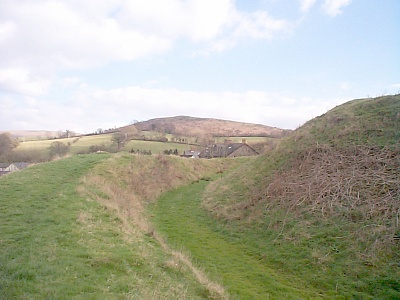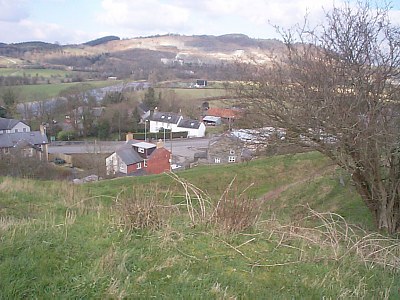All that remains to see of the original stone-built castle are a series of
grassy humps. Looking at the castle from the other side of the river it is easy
to imagine how imposing Castell Buallt was, overlooking the fording point of the
river Wye.
The castle, as we know it, is believed to have been built on the
site of an original earth built motte and bailey. Legend has it that the stone
from the castle which fell into disuse in the reign of Elizabeth I was used in
the rebuilding of the town, but I doubt the truth of that.

One of the many stories that surround the death of Llewelyn says that the
gatekeeper of the castle at Builth refused entry to Llewelyn, he then took
refuge in a cave near Aberedw and he was then slain by English knights at
Cilmery (Cefn-y-bedd), to the west of Builth. His head was severed and taken to
be paraded in the London, while his body was taken to Abbey-cwm-hir, a few miles
to the north, and site of a cistercian abbey. Another story has it that Llewelyn
and his army camped at Rhosferreg, just across the river Irfon, and near
Cilmery. On a recce, or on his way to a meeting at Llanynis, he was killed by a
party of English soldiers who didn't at first realise who he was. But, there are
many variations on both of these tales, and even more different stories.
At Cilmery (Cilmeri or Cefn-y-bedd), two
miles to the west along the A483, a monument to the death of Llewelyn has been
erected. This large monolith replaces an early, smaller, but attractive monument
which is now incorporated into the walls of the steps leading to monument. At
the rear of the monument site is Llewelyn's well, like many others, is said to
bring good luck in return for a coin tossed into the water.The castle
site, often used for grazing land, is owned by White House farm, the farmhouse
itself dates back to 18th century. (The farm is the white building in the
centre of this view from bailey of the castle.) The castle is under the
control of CADW - the Wales department that looks after ancient monuments. The Castles of
Wales web site has page upon page on the Welsh castles and the many historic
figures who influenced the forming of Wales. Builth castle has an excellent
article, well illustrated on the site. To the west of Builth, near Caer Beris
manor, is the remains of another castle, much smaller than that of Builth. A
look at the Castles of Wales website or at an Ordnance Survey map of the area
reveals many more castle, or mottes scattered over the area, a fair indicator of
the troubles of those early years. Little seems to have been undertaken to
discover any archaeoligical evidence of the castle (apart from a dig in 1970s by
Prof Spurgeon). Several underground bunkers are rumoured to have been dug during
the Second World War for ammunition dumps, but were abondoned because of water
and collapse, and there are certainly marks on two of the banks which back this
story.


